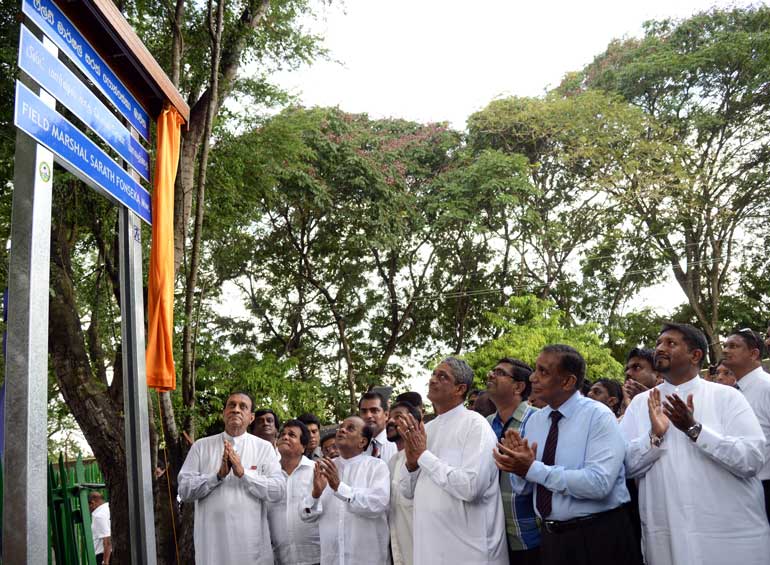Friday Dec 12, 2025
Friday Dec 12, 2025
Saturday, 23 May 2015 00:00 - - {{hitsCtrl.values.hits}}

The road linking Ananda Mawatha and Ketawalamulla Road in Colombo 10 was named after Field Marshal Sarath Fonseka on 19 May by the Colombo Municipal Council (CMC)
Another road-naming ceremony took place a few days ago in the Colombo City. The road linking Ananda Mawatha and Ketawalamulla Road in Maradana (Colombo 10) was named after Field Marshal Sarath Fonseka. It was not clear whether it was a new road or whether it had another name earlier.
It was reported that the naming of the road followed instructions by the President to the Colombo Municipal Council (CMC) that a road be named to recognise Field Marshal Fonseka’s dedicated service for the protection of the country’s sovereignty and territorial integrity.
Well and good. No one is going to quarrel about a road being named after Field Marshal Fonseka. He fully deserves such recognition. But what people would like to know is how the location was selected. Was it the area where he lived? What was special in selecting this road?
We know he attended Ananda College as a student. Is that why this location was thought of? Did anyone look at the possibility of naming a road which had some link to the Army? Or was it a hasty decision to name any road available on the day the war in the north ended? A clarification from the CMC will be most welcome.
Not all changes are meaningful
Looking at other roads where the age old names have been changed, some were meaningful while others were not. Let’s look at just two examples. Dickman’s Road was named ‘Lester James Peries Mawatha’ (although no CMC official cared to check how he spelt the name ‘Peries’) obviously because he had lived there for many years.
Then Guildford Crescent was renamed ‘Acharya Premasiri Khemadasa Mawatha’. True that Khemadasa Master (as he was fondly known to everyone) staged some of his operas at the Lionel Wendt Theatre, but wouldn’t it have been better if a busy road around Borella or Rajagiriya where he lived was renamed in his honour? More so because Lionel Wendt was himself a renowned artiste and he had donated his house to the Theatre. But for several decades after his death even, no one thought of giving him the recognition he deserved.
The other point is that it’s only through usage over many years that a new name gets registered in our minds. How long did it take us to remember that Turret Road had been renamed Anagarika Dharmapala Mawatha? I wonder how many remember that Reid Avenue is now ‘Philip Gunawardena Mawatha’? Or Havelock Road is ‘Sambuddhattva Jayanthi Mawatha’?
Ideally a name of a road should be one that is short and easy to remember. When it’s a long name, how many even make an attempt to remember it. It may be interesting to find out how many letters LJP gets (of course, in this email/SMS age letter writing is minimal!) addressed to No… Dickman’s Road, other than those from the Inland Revenue Department or some other Government institution because they are expected to use only the officially recognised road names.
The name-changing process
I have read that the Municipal Council Ordinance provides that the Council shall determine the name by which any street shall be known, and may at any time alter the name of any street.
Before any private street is given a name or before the name of any private street is altered, the Council causes notice of the proposed name be posted at either end of such street, and to be given to the owners of the land abutting such street; and any such owner may, within 15 days of the posting of the notice or the date on which the notice is given, whichever is later, object to the proposed name, by sending the Council a written statement containing the grounds on which his objections are based. After considering the objections, if any, the Council will determine the name by which such private street shall be known.
Interesting anecdotes
In the CMC Centenary Volume (1965) there are a few interesting anecdotes on naming of roads. In trying to select a name which had been ‘taken over’ by the Council, the Chairman (pre-Mayor days obviously) consulted the residents. One said he owned all the land in the street and wanted it to be ‘Perera Lane’. Another, de Silva, said that Perera was an undesirable person and wanted it to be called ‘de Silva Lane’. The Chairman gave it a good Aryan name which ran into three words so that senders of telegrams had to pay for three words instead of one!
Another story relates to what happened when ‘Temple Lane’ was suggested for a street which had a temple in it. But there were already four Temple Lanes. The roads engineer (a Ceylonese) suggested a typical English name. When he was asked the origin of the name, he said that it was the name of the road in Bloomsbury in which he had digs when studying in England. It was approved.
Here is the third. General Lake’s Road was named after a General called Lake who lived in Braybrooke Lodge. It was not named after the lake along which it runs. In 1961 this road was named ‘Sir James Peiris Mawatha’.